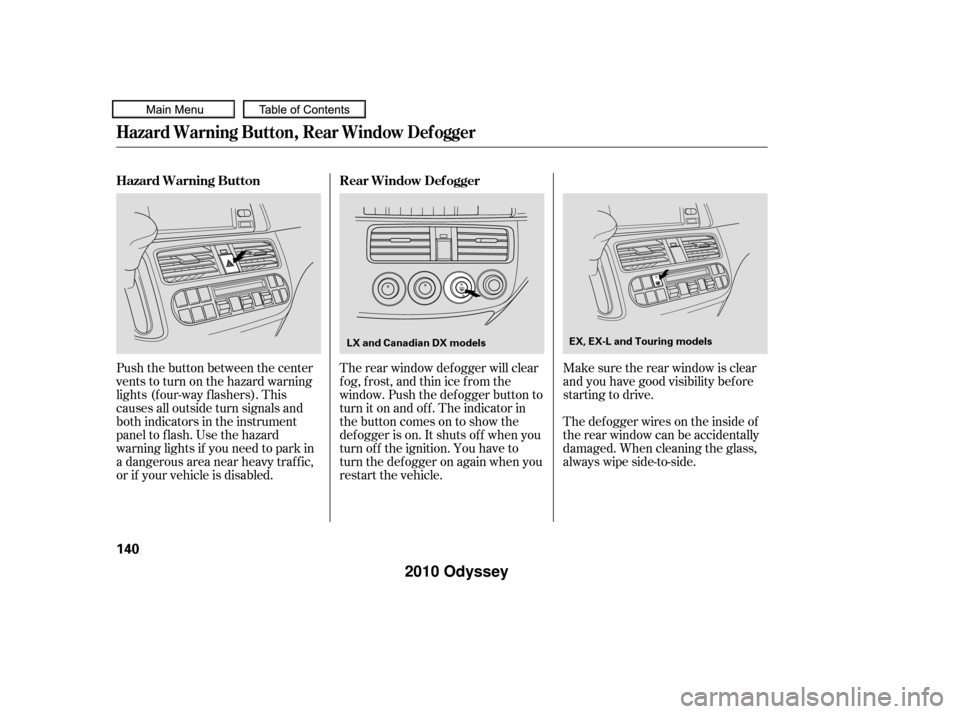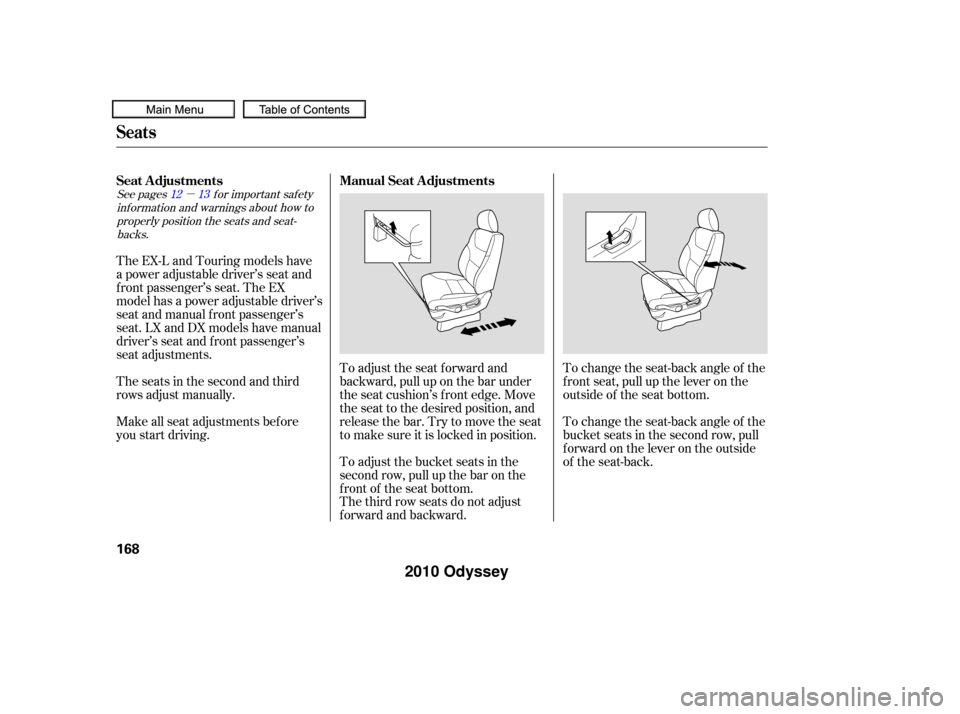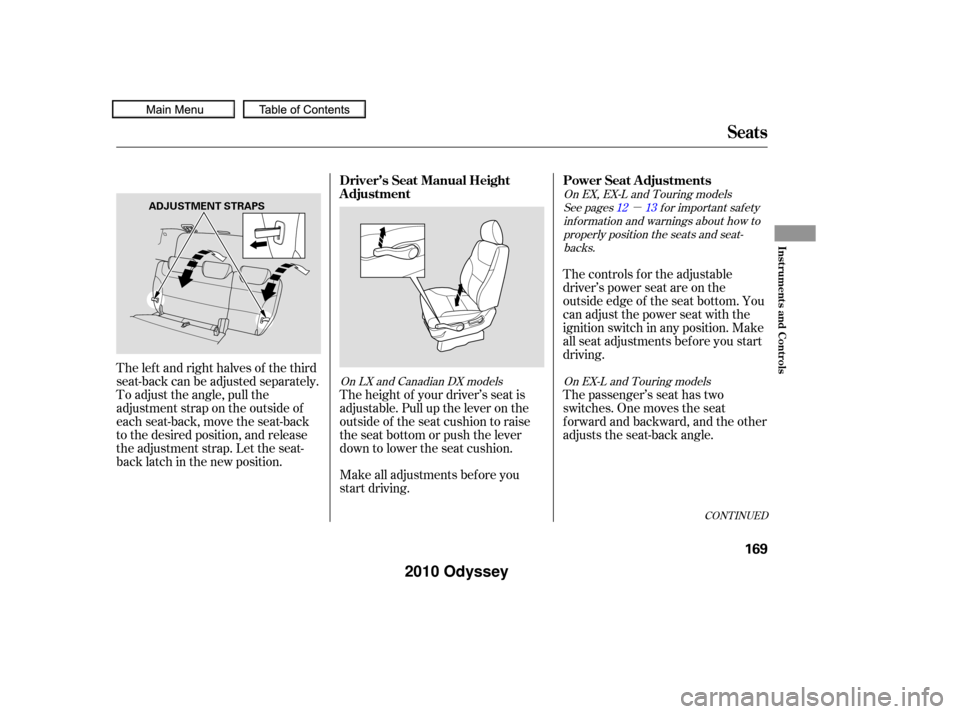Page 98 of 526
This message, and the indicator to
the lef t of the message, is part of the
parking sensor system. If you are
approaching too close to an object,
you will see ‘‘WARNING:
APPROACHING OBJECT’’ on the
display and hear a beeper. See pagef or more inf ormation.
If the passenger’s side airbag has
automatically shut of f , you will see
‘‘PASSENGER SIDE AIRBAG OFF’’
on the multi-inf ormation display. See
page f or more inf ormation.
If one or more of your vehicle tires
are low on pressure, you will see a
‘‘CHECK TIRE PRESSURE’’
message on the display. See page
f or more inf ormation on the tire
pressure monitoring system (TPMS).
35
399
362
CONT INUED
Passenger Side A irbag Of f Check T ire PressureWarning: A pproaching Object
Multi-Inf ormation Display
Inst rument s and Cont rols
95
U.S.
Canada
�����—�����—�
���y�
����
��������y���
�(�����������y���
�����y
2010 Odyssey
Page 136 of 526

�Î�Î
�Î
�Î �Î
�Î �Î �Î�Î
�Î
�Î
�Î
�Î
�Î
�Î
�ÎTo use the horn, press the center pad of the steering wheel.
Only on vehicles equipped with navigation system. Ref er to the navigation system manual.
If equipped
1:
2:
3:
Controls Near the Steering Wheel
Inst rument s and Cont rols
133
HAZARD WARNING
BUTTON
WINDSHIELD WIPERS/WASHERS
REAR WINDOW WIPER/WASHER
CRUISE CONTROL
BUTTONS
VEHICLE STABILITY
ASSIST (VSA) OFF
SWITCH PASSENGER
AIRBAG OFF
INDICATOR
LIGHT CONTROL
SWITCH
STEERING WHEEL
ADJUSTMENT (P.
35)
NAVIGATION
SYSTEM
BUTTONS HORN
(P.193)
(P.189) (P.282)
(P.141) (P.134)
(P.135)
(P.319 )
(P. 281 )
(P. 140 )
(P.221, 285)
(P.205) REAR WINDOW
DEFOGGER BUTTON
(P.140)
PEDAL POSITION
ADJUSTMENT SWITCH
POWER SLIDING DOOR
SWITCH
MOONROOF SWITCH
POWER TAILGATE
SWITCHPARKING SENSOR
SYSTEM SWITCH MULTI-INFORMATION
BUTTONSAUDIO SYSTEM/
REAR
ENTERTAINMENT
SYSTEM CLOCK
HEADLIGHTS/TURN SIGNAL/
FOG LIGHTS
(P.162)
(P.158)/
(P.82)
(P.135,
138)
REMOTE AUDIO
CONTROL BUTTONS (P.395)
VEHICLE STABILITY
ASSIST (VSA) OFF
SWITCH (P.395)
(P.327)
BLUETOOTH
HANDSFREELINK
BUTTONS
(P.361)
2 1
3
3 3
3 3 33
3
3
3
3
�����—�����—�����y�
�������������y���
�(�����������y���
�����y
2010 Odyssey
Page 143 of 526

The def ogger wires on the inside of
the rear window can be accidentally
damaged. When cleaning the glass,
always wipe side-to-side. Make sure the rear window is clear
and you have good visibility bef ore
starting to drive.
The rear window def ogger will clear
fog, frost, and thin ice from the
window. Push the def ogger button to
turn it on and off. The indicator in
the button comes on to show the
def ogger is on. It shuts of f when you
turn of f the ignition. You have to
turn the def ogger on again when you
restart the vehicle.
Push the button between the center
vents to turn on the hazard warning
lights (f our-way f lashers). This
causes all outside turn signals and
both indicators in the instrument
panel to f lash. Use the hazard
warning lights if you need to park in
a dangerous area near heavy traffic,
or if your vehicle is disabled. Hazard Warning Button
Rear Window Def ogger
Hazard Warning Button, Rear Window Def ogger
140
LX and Canadian DX models EX, EX-L and Touring models
�����—�����—�
���y�
����
��������y���
�(�����������y���
�����y
2010 Odyssey
Page 171 of 526

�µ
See pages f or important saf ety
inf ormation and warnings about how toproperly position the seats and seat-backs. 1312
The third row seats do not adjust
f orward and backward. To adjust the seat forward and
backward, pull up on the bar under
the seat cushion’s f ront edge. Move
the seat to the desired position, and
releasethebar.Trytomovetheseat
to make sure it is locked in position.
To adjust the bucket seats in the
second row, pull up the bar on the
front of the seat bottom. To change the seat-back angle of the
f ront seat, pull up the lever on the
outside of the seat bottom.
To change the seat-back angle of the
bucket seats in the second row, pull
forwardontheleverontheoutside
of the seat-back.
The EX-L and Touring models have
a power adjustable driver’s seat and
f ront passenger’s seat. The EX
model has a power adjustable driver’s
seat and manual f ront passenger’s
seat. LX and DX models have manual
driver’s seat and f ront passenger’s
seat adjustments.
The seats in the second and third
rows adjust manually.
Make all seat adjustments bef ore
you start driving. Seat Adjustments
Manual Seat Adjustments
Seats
168
�����—�����—�
���y�
������
������y���
�(�����������y���
�����y
2010 Odyssey
Page 172 of 526

�µ
Make all adjustments bef ore you
start driving. The height of your driver’s seat is
adjustable. Pull up the lever on the
outside of the seat cushion to raise
the seat bottom or push the lever
down to lower the seat cushion.
The lef t and right halves of the third
seat-back can be adjusted separately.
To adjust the angle, pull the
adjustment strap on the outside of
each seat-back, move the seat-back
to the desired position, and release
the adjustment strap. Let the seat-
back latch in the new position. The controls f or the adjustable
driver’s power seat are on the
outside edge of the seat bottom. You
can adjust the power seat with the
ignition switch in any position. Make
all seat adjustments bef ore you start
driving.
The passenger’s seat has two
switches. One moves the seat
f orward and backward, and the other
adjusts the seat-back angle.
CONT INUED
See pages f or important saf ety
inf ormation and warnings about how toproperly position the seats and seat-backs.
On LX and Canadian DX models On EX, EX-L and Touring models
On EX-L and Touring models12 13
Driver’s Seat Manual Height
Adjustment
Power Seat A djustments
Seats
Inst rument s and Cont rols
169
ADJUSTMENT STRAPS
�����—�����—�
���y�
������
������y���
�(�����������y���
�����y
2010 Odyssey
Page 174 of 526
They are most ef f ective when you
adjust them so the center of the back
of the occupant’s head rests against
the center of the restraint.
An armrest is located on each of the
frontseatsandoneachsideof the
second row seats (depending on
models).Pivotitdowntouseit.
When you remove the bucket seats
in the second row, pivot the armrests
up out of the way.
Theangleof thearmrestoneach
f ront seat is adjustable. Pivot the
armrest down, and pull it up to the desired angle.
Your vehicle is equipped with head
restraints in all seating positions to
help protect you and your
passengers f rom whiplash and other
injuries.
CONT INUED
See page f or important saf ety
inf ormation and a warning aboutimproperly positioning head restraints.
On EX-L and Touring models 14
Armrests
Head Restraints
Seats
Inst rument s and Cont rols
171
�����—�����—�
���y�
���������
���y���
�(�����������y���
�����y
2010 Odyssey
Page 403 of 526

�µ
Although your tire pressure is
monitored, you must manually check
thetirepressuresmonthly.
Each tire, including the spare, should
be checked monthly when the
vehicle is cold, and set to the
recommended inf lation pressure as
specif ied on the vehicle placard and
intheowner’smanual(seepage).
If the tire is f lat, or if the tire
pressure is too low to continue
driving, replace the tire with the
compact spare tire (see page ). If you think you can saf ely drive a
short distance to a service station,
proceed slowly to the station, then
inflate the tire to the recommended
pressure. If you have a f lat tire, the low tire
pressure/TPMS and tire monitor
indicators will come on. Replace the
indicated f lat tire with the compact
sparetire(seepage ).
After the flat tire is replaced with the
spare tire, the low tire pressure/
TPMS indicator stays on while
driving. Af ter several miles
(kilometers) driving, this indicator
begins to f lash, then stays on again.
You will also see a ‘‘CHECK TPMS
SYSTEM’’ message on the multi-
inf ormation display. This is normal;
the system cannot monitor the spare
tire pressure. Manually check the
spare tire pressure to be sure it is
correct.
This indicator and the warning
message on the multi-inf ormation
display will go of f , af ter several miles
(kilometers) driving, when the spare
tire is replaced with the specifiedregular tire equipped with the tire
pressure monitor sensor.
Never use a puncture-repairing agent
in a f lat tire. If used, you will have to
replace the tire pressure sensor.
Havetheflattirerepairedbyyour
dealer as soon as possible.
Each wheel is equipped with a tire
pressure sensor mounted inside the
tire behind the valve stem. You must
use TPMS specif ic wheels. It is
recommended that you always have
your tires serviced by your dealer or
a qualif ied technician.
451
462 463
Changing a T ire with T PMS
Tire Pressure Monitoring System (TPMS) Touring models
400
�����—�����—�
���y�
�������������y���
�(�����������y���������y
2010 Odyssey
Page 461 of 526

�µ
Check the condition of the battery
monthlybylookingatthetest
indicator window. The label on the
battery explains the test indicator’s
colors. Check the terminals f or corrosion (a
white or yellowish powder). To
remove it, cover the terminals with a
solution of baking soda and water. It
will bubble up and turn brown. When
this stops, wash it of f with plain
water. Dry off the battery with a
cloth or paper towel. Coat the
terminals with grease to help prevent
f uture corrosion.
If additional battery maintenance is
needed, see your dealer or a
qualif ied technician.
Battery posts,
terminals, and related accessories
contain lead and lead compounds. If you need to connect the battery to
a charger, disconnect both cables to
prevent damaging your vehicle’s
electrical system. Always disconnect
the negative ( ) cable first, and
reconnect it last.
WARNING:
Wash your hands af ter handling.
Checking the Battery
458
TEST INDICATOR WINDOW
The battery gives off explosive
hydrogen gas during normal
operation.
A spark or flame can cause the
battery to explode with enough
force to kill or seriously hurt you.
Wear protective clothing and a
face shield, or have a skilled
technician do the battery
maintenance.
�����—�����—�
���y�
������
����
�y���
�(�����������y���������y
2010 Odyssey